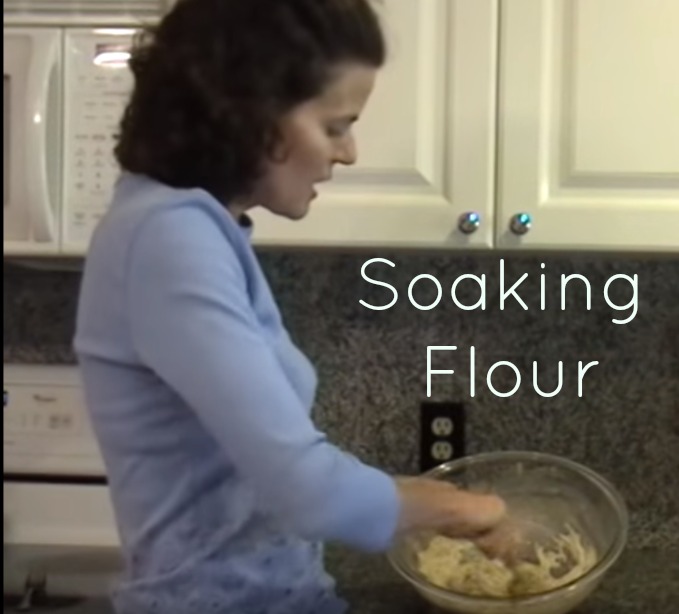Table of Contents[Hide][Show]
Soaking flour for maximum digestibility is one of the three traditional methods of grain preparation for healthy, nutritious bread as practiced by Ancestral cultures.
One of the most important baking techniques to learn when implementing a traditional diet is soaked flour. This ancestral method of grain preparation enhances digestibility and improves the metabolism of nutrients.
This technique also reduces anti-nutrients such as phytic acid in the grain flour. These substances block mineral absorption and can aggravate inflammation of the intestinal tract. Gluten-free grains also contain these anti-nutrients.
Other methods for reducing anti-nutrients in grains and improving metabolism include sour leavening (sourdough) and sprouting.
How to Soak Flour
Soaking flour is simple. Simply mix grain flour with yogurt, kefir, or clabbered milk, cover with a dishtowel, and let sit on the counter overnight. Freshly ground flour produces the best results. After the allotted soaking time, blend in the remaining ingredients and bake or cook as usual.
Non-grain based flours such as cassava and coconut flour do not need soaking. Others such as almond flour and chickpea flour are best soaked before grinding rather than after.
Dairy-Free
For those with milk allergies, substitute 1 cup of filtered water per cup of flour plus 2 TBL of lemon juice or apple cider vinegar and soak as usual for at least 8 hours or overnight.
For those with more extreme wheat sensitivities, the soaking time can be increased up to 24 hours to further breakdown gluten and other anti-nutrients.
Soaking any longer than 24 hours risks the development of mold.
Soaking Flour Technique Applies to All Grains
The principle of soaking can be applied to whole grains as well, such as your morning oatmeal. It was common to soak oats overnight before cooking back before WWII. This step was apparently even suggested on the Quaker oatmeal box!
It seems with the modern preference for speed in food preparation, this essential step has been lost. Hardly anyone under the age of 80 even remembers it anymore.
Try soaking your oatmeal the night before and see how much more filling it is after you cook and eat it the next morning.
Instead of being hungry again at 10 am, you will likely be full right through until lunch! To soak oatmeal, use 1 cup of warm filtered water per cup of oats plus 2 TBL whey, yogurt, kefir, or buttermilk. Stir together in the pot you will cook them in, cover with the lid, and leave overnight.
Cook, as usual, the next morning.
Bread Recipes Using Soaked Flour
Try this soaked bread recipe with your soaked flour. You can also try making a soaked loaf in a bread machine.
The video in the recipe tutorial below demonstrates visually the simple process of soaking flour. Try it with your next flour-based recipe!

How to Soak Flour
How to soak flour of all kinds before making the batter to improve digestibility and nutritional benefits of bread and other baked goods.
Ingredients
- 2 cups flour preferably freshly ground and organic
- 2 cups whole milk yogurt
Instructions
-
Mix flour and yogurt in a large bowl.
-
Cover with a clean dishcloth and secure with a large rubber band.
-
Leave on the counter overnight or for 8 hours.
-
Uncover, mix in remaining ingredients for whatever recipe you wish to make and bake as usual.
Recipe Video
Recipe Notes
Clabbered milk or plain kefir may be substituted for yogurt.
If there is a dairy allergy, 2 cups of water plus 2 Tbl lemon juice may be substituted. This reduces the calories to 910 for one batch.








I just soaked my flour for the first time today. I covered it with apple cider vinegar and water, as recommended and when I took it out after eight hours, it was indeed very glue like. However, I then went to make the rest of the recipe as usual (it calls for a pint of milk) and even adding only 1/2 a pint of milk has turned it into a batter. Normally it goes into the oven as a dry round dough. Soaking has totally changed this. Please help! I thought I was supposed to use the same recipe as normal.
Lynn, the same thing is happening to me, and I came here to inquire about it, as it’s no different than just adding extra cups of water to whatever I’m making which of course is going to throw off the ratios. I am soaking sprouted gluten free flour, so I’m not even getting the glue like texture from the gluten in wheat. My baking is not turning out well! It’s all runny and double the liquid content it should be. I had to add 3 more cups of just sprouted flour to my pancake mixture because it was pure liquid, and my oatmeal was a watery soup instead of creamy milky oats.
I am soaking flour right now for muffins tomorrow morning, and I am going to try straining the liquid through a cheesecloth first. I will let you know how it goes, as I’m hoping it’ll be able to separate enough out to “dry” the flour a bit before adding it to my recipe. And for pancakes and oatmeal, I think I will try soaking the grains in the milk that is already called for in the recipe + the lemon juice or ACV and not adding more liquid, just the baking soda and all that. It will turn the milk into “buttermilk” which is what I do anyway for pancakes. Anyway, I will let you know! Hopefully straining the water out with cheesecloth can be an easy solution.
Lynn, I’m just reporting back. Apparently my cloth was too loose, as I woke up to the cloth being soaked after absorbing a lot of the liquid because it had fallen into the soaking flour a bit. I tried to strain what was left through a cheesecloth, but it was no use. Too runny to use in a recipe but too thick to actually strain and separate the water. I made my muffins anyway and added an additional two cups of flour because they didn’t cook at all with that much liquid and am giving up. I’ll just keep on sprouting but no soaking. A shame, but better than nothing. I don’t understand how to make it work unless maybe using a tiny bit of water to soak instead of the one to one ratio.
Thanks for all the great videos, they really make it seem less difficult to attempt the traditional way of preparing food. I’ve tried the crispy nuts and they turned out really well.
My family are gluten free, would you recommend soaking gluten free grains and flours too. I generally use Brown Rice Flour, Sorghum Flour, Tapioca Flour, Glutinous (Sweet) Rice Flour, Besan (Chickpea) Flour, Amaranth Flour and Coconut Flour.
Thanks again
Sarah, not sure if anyone asked this already but what do you use to mill your flour? I just tried my first home made flour using the VitaMix. It’s not completely “fine” but I don’t really care.
Tnx,
Hi Sarah,
I am planning to bake a cake and want to soak my flour. You said not to use pasturized milk, but can I use pasturized cultured buttermilk to soak the flour overnight. Thanks, Diane
Hi Sarah
At the moment I am still trying to source a good supply of spelt grain, in my area to sprout, dehydrate then grind. In the interim what do you think of soaking the flour I have, dehydrating, grinding up and then using to cook like flour. I have soaked flour before but my dilema is that soaked flour does not always cook up as well in some of my favourite recipes. From a taste and texture point of view I can compromise but my children are 11 & 7 and not always so keen to compromise. Thanks
I’m a little confused about spouting and soaking. Is the flour that you are soaking for the pancakes from wheat that was sprouted, and then grinded and then soaked, of wheat that was just grinded and soaked? Thanks.
THANKS so much for all you do. I have a group called Crunchy Momma’s on FB that me and a friend head up. We are constantly posting your videos. We have so many momma’s adding kefir and kombucha to their diets already!!! So exciting! I just got my mill in the mail. I am so excited.
So a friend told me about an article she saw that soaking with whey causes the calcium to break down the phytic acid? Any info on this?
Can skimmed raw milk and regular raw milk be used to soask? Thanks for the great video!!